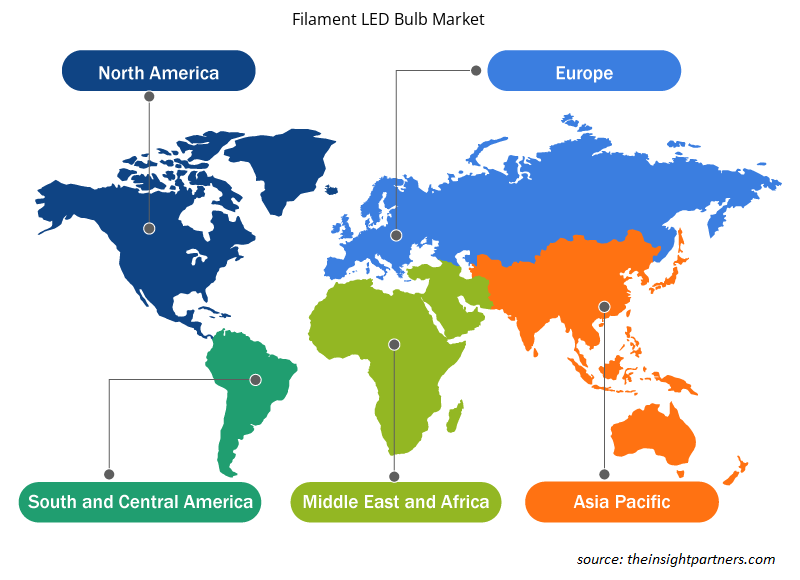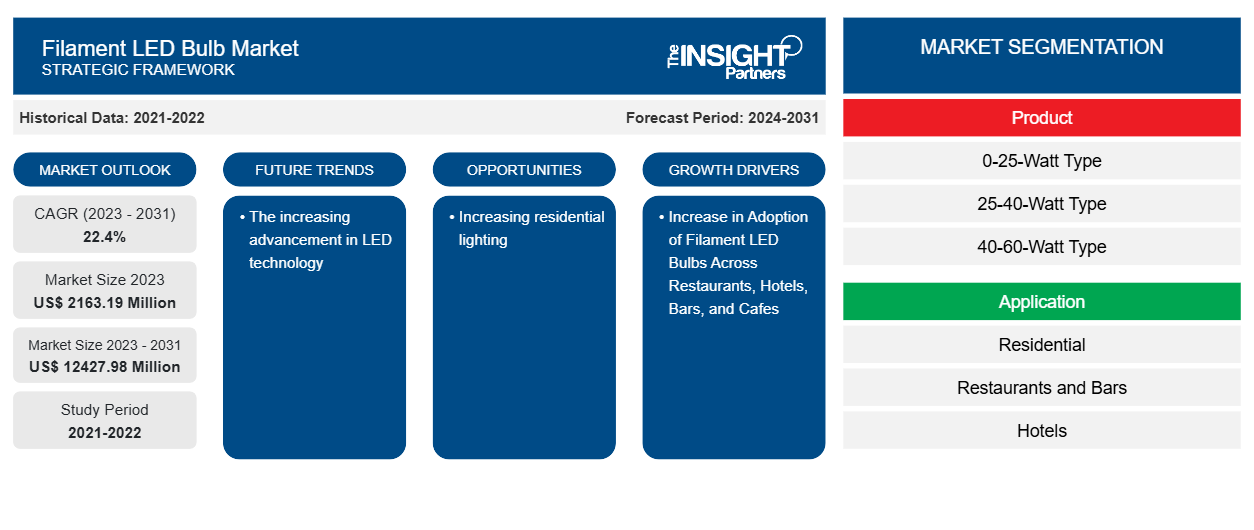Se prevé que el tamaño del mercado de bombillas LED de filamento alcance los 12 427,98 millones de dólares en 2031, frente a los 2163,19 millones de dólares en 2023. Se espera que el mercado registre una CAGR del 22,4 % durante el período 2023-2031. Es probable que el avance creciente en la tecnología LED siga siendo una tendencia clave en el mercado.CAGR of 22.4% during 2023–2031. The increasing advancement in LED technology is likely to remain a key trend in the market.
Análisis del mercado de bombillas LED de filamento
El crecimiento del mercado se atribuye al creciente número de proyectos de construcción residencial y comercial en diferentes regiones. Además, el aumento del interés en las actividades de renovación y remodelación de viviendas, que puede vincularse con un mayor apoyo gubernamental, en particular en los países industrializados, también está impulsando la demanda de bombillas LED de filamento. El aumento de los niveles de ingresos de los consumidores, los cambios en los estilos de vida y la aceptación de diversas culturas en términos de decoración de interiores están contribuyendo a esta transición.
Descripción general del mercado de bombillas LED de filamento
Las bombillas LED de filamento mejoran la apariencia y la dispersión de la luz de las bombillas incandescentes al tiempo que utilizan la tecnología LED para proporcionar una iluminación eficiente y un rendimiento confiable. Las bombillas LED de filamento, comúnmente conocidas como bombillas Edison, muestran filamentos brillantes de gran tamaño a través de carcasas de vidrio transparente y se asemejan a las bombillas incandescentes o vintage antiguas. Las bombillas LED de filamento brindan el aspecto de las bombillas incandescentes tradicionales al tiempo que brindan una iluminación de bajo consumo y todas las demás ventajas de la iluminación LED tradicional. Las bombillas LED de filamento tienen una vida útil más larga que las bombillas incandescentes.
Personalice este informe según sus necesidades
Obtendrá personalización en cualquier informe, sin cargo, incluidas partes de este informe o análisis a nivel de país, paquete de datos de Excel, así como también grandes ofertas y descuentos para empresas emergentes y universidades.
- Obtenga las principales tendencias clave del mercado de este informe.Esta muestra GRATUITA incluirá análisis de datos, desde tendencias del mercado hasta estimaciones y pronósticos.
Impulsores y oportunidades del mercado de las bombillas LED de filamento
Aumento de la adopción de bombillas LED de filamento en restaurantes, hoteles, bares y cafeterías
La iluminación es un elemento importante en el diseño general de restaurantes y cafeterías. En cafeterías, bares y restaurantes, la intensidad de luz de 150 lux se considera generalmente apropiada. Otras áreas requieren 100 lux, la sección de almacenamiento de alimentos requiere 150 lux, la sección de lavado requiere 300 lux y la sección de cocina requiere 500 lux. Los restaurantes emplean cuatro tipos de iluminación: iluminación general, iluminación de acento, iluminación decorativa e iluminación natural. En una cafetería o restaurante, la iluminación general es el aspecto más importante. La iluminación homogénea se logra colocando el equipo de iluminación en un cierto orden al mismo tiempo. Los clientes percibirán el restaurante como más acogedor si tiene una decoración general decente. La iluminación de acento se puede emplear para llamar la atención sobre los aspectos principales o elegantes de los restaurantes, incluida la decoración, las plantas, las mesas o la mercancía. La iluminación decorativa se refiere a los componentes de iluminación que se emplean para completar el diseño. La iluminación tradicional y moderna se puede utilizar para crear una iluminación decorativa. Así, diversas técnicas de iluminación utilizadas en restaurantes, hoteles, bares y cafeterías están impulsando la adopción de bombillas LED de filamento, contribuyendo así al crecimiento del mercado.
Aumento de la iluminación residencial
La iluminación está aumentando en las zonas residenciales. El uso de bombillas LED en los hogares difiere de otras características del hogar, como los ingresos familiares y la propiedad. Entre los hogares que ganan menos de $20,000 por año, el 39% informó que las bombillas LED eran su principal opción de iluminación interior, mientras que el 54% de los hogares que ganan $100,000 o más por año utilizaron principalmente bombillas LED en 2020. Las bombillas LED de filamento se utilizan ampliamente en áreas residenciales. Por lo tanto, el aumento de la iluminación residencial está generando más oportunidades para el mercado de bombillas LED de filamento.
Análisis de segmentación del informe de mercado de bombillas LED de filamento
Los segmentos clave que contribuyeron a la derivación del análisis del mercado de bombillas LED de filamento son el producto y la aplicación.
- Según el producto, el mercado de bombillas LED de filamento se divide en el tipo de 0 a 25 vatios, el tipo de 25 a 40 vatios, el tipo de 40 a 60 vatios y el tipo de más de 60 vatios. El segmento de 0 a 25 vatios tuvo una mayor participación de mercado en 2023.
- Por aplicación, el mercado está segmentado en residencial, restaurantes y bares, hoteles, cafeterías y otros.café, and others.
Análisis de la cuota de mercado de las bombillas LED de filamento por geografía
El alcance geográfico del informe del mercado de bombillas LED de filamento se divide principalmente en cinco regiones: América del Norte, Asia Pacífico, Europa, Medio Oriente y África, y América del Sur y Central.
Europa lideró el mercado de bombillas LED de filamento en 2023. En Europa, al igual que los Planes de Acción Nacionales de Eficiencia Energética (PANE), los Planes de Acción Nacionales de Eficiencia Energética (PANE) tienen como objetivo promover las inversiones en el mantenimiento y la renovación de edificios residenciales y comerciales. Además, la disposición de los consumidores a gastar cantidades importantes en el diseño de los espacios habitables ha atraído su atención hacia productos de decoración del hogar como alfombras y tapetes, y sistemas de iluminación avanzados y estilizados que mejoran el atractivo estético de los interiores.NEEAPs) and the National Energy Efficiency Action Plans (NEEAPs), the National Energy Efficiency Action Plans (NEEAPs) aim to promote investments in the maintenance and refurbishment of residential and commercial buildings. Further, consumers’ willingness to spend important amounts on the styling of living spaces has drawn their attention to home furnishing products such as carpets and rugs, and advanced and styled
Perspectivas regionales del mercado de bombillas LED de filamento
Los analistas de Insight Partners han explicado detalladamente las tendencias y los factores regionales que influyen en el mercado de bombillas LED de filamento durante el período de pronóstico. Esta sección también analiza los segmentos y la geografía del mercado de bombillas LED de filamento en América del Norte, Europa, Asia Pacífico, Oriente Medio y África, y América del Sur y Central.

- Obtenga datos regionales específicos para el mercado de bombillas LED de filamento
Alcance del informe de mercado de bombillas LED de filamento
| Atributo del informe | Detalles |
|---|---|
| Tamaño del mercado en 2023 | US$ 2163,19 millones |
| Tamaño del mercado en 2031 | US$ 12427,98 millones |
| CAGR global (2023 - 2031) | 22,4% |
| Datos históricos | 2021-2022 |
| Período de pronóstico | 2024-2031 |
| Segmentos cubiertos | Por producto
|
| Regiones y países cubiertos | América del norte
|
| Líderes del mercado y perfiles de empresas clave |
|
Densidad de actores del mercado de bombillas LED de filamento: comprensión de su impacto en la dinámica empresarial
El mercado de bombillas LED de filamento está creciendo rápidamente, impulsado por la creciente demanda de los usuarios finales debido a factores como la evolución de las preferencias de los consumidores, los avances tecnológicos y una mayor conciencia de los beneficios del producto. A medida que aumenta la demanda, las empresas amplían sus ofertas, innovan para satisfacer las necesidades de los consumidores y aprovechan las tendencias emergentes, lo que impulsa aún más el crecimiento del mercado.
La densidad de actores del mercado se refiere a la distribución de las empresas o firmas que operan dentro de un mercado o industria en particular. Indica cuántos competidores (actores del mercado) están presentes en un espacio de mercado determinado en relación con su tamaño o valor total de mercado.
Las principales empresas que operan en el mercado de bombillas LED de filamento son:
- Lámparas Crompton Ltd.
- Compañía Havells India Ltd.
- Iluminación para el consumidor Wipro
- MEGAMAN
- OSRAM GmbH
- Significar la celebración (Philips)
Descargo de responsabilidad : Las empresas enumeradas anteriormente no están clasificadas en ningún orden particular.

- Obtenga una descripción general de los principales actores clave del mercado de bombillas LED de filamento
Noticias y desarrollos recientes del mercado de bombillas LED de filamento
El mercado de las bombillas LED de filamento se evalúa mediante la recopilación de datos cualitativos y cuantitativos a partir de una investigación primaria y secundaria, que incluye importantes publicaciones corporativas, datos de asociaciones y bases de datos. A continuación, se enumeran algunos de los avances en el mercado de las bombillas LED de filamento:
- Feit Electric Company, Inc. (“Feit Electric”), una marca líder mundial en iluminación y hogares inteligentes con sede en California, anunció hoy que un conjunto de patentes protege sus innovadoras bombillas con filamentos blancos visibles, las “patentes de filamento blanco”.
(Fuente: Trellix, comunicado de prensa, octubre de 2023).
- Además, en enero Life on Products, Inc. lanzó más luces LED de filamento. (Fuente: PamTen Inc, comunicado de prensa, enero de 2023)
Informe de mercado de bombillas LED de filamento: cobertura y resultados
El informe “Tamaño y pronóstico del mercado de bombillas LED de filamento (2021-2031)” proporciona un análisis detallado del mercado que cubre las siguientes áreas:
- Tamaño del mercado de bombillas LED de filamento y pronóstico a nivel mundial, regional y nacional para todos los segmentos clave del mercado cubiertos bajo el alcance
- Tendencias del mercado de bombillas LED de filamento, así como dinámica del mercado, como impulsores, restricciones y oportunidades clave
- Análisis detallado de las cinco fuerzas de Porter y PEST y FODA
- Análisis del mercado de bombillas LED de filamento que cubre las tendencias clave del mercado, el marco global y regional, los principales actores, las regulaciones y los desarrollos recientes del mercado
- Análisis del panorama de la industria y de la competencia que abarca la concentración del mercado, el análisis de mapas de calor, los actores destacados y los desarrollos recientes del mercado de bombillas LED de filamento
- Perfiles detallados de empresas
- Análisis histórico (2 años), año base, pronóstico (7 años) con CAGR
- Análisis PEST y FODA
- Tamaño del mercado, valor/volumen: global, regional y nacional
- Industria y panorama competitivo
- Conjunto de datos de Excel
Informes recientes
Testimonios
Razón para comprar
- Toma de decisiones informada
- Comprensión de la dinámica del mercado
- Análisis competitivo
- Información sobre clientes
- Pronósticos del mercado
- Mitigación de riesgos
- Planificación estratégica
- Justificación de la inversión
- Identificación de mercados emergentes
- Mejora de las estrategias de marketing
- Impulso de la eficiencia operativa
- Alineación con las tendencias regulatorias





















 Obtenga una muestra gratuita para - Mercado de bombillas LED de filamento
Obtenga una muestra gratuita para - Mercado de bombillas LED de filamento